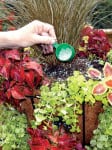How to Trim and Fertilize Container Gardens (Video, 1:21)
By Pamela Crawford
This video shows how to trim and fertilize container gardens. Here’s some additional information on fertilization you might find helpful. It is taken from Pamela’s book, ‘Easy Container Gardens.’
Fertilizer is one of the most important components of blue ribbon plants and easy container gardens. Remember, the blue ribbon plants only require water after you plant them. But, that is possible only if you use a fertilizer at planting time that lasts the entire lifespan of the arrangement. Without fertilizer, the plants will slowly turn yellow and decline.
I have only found one fertilizer that works perfectly every time. And it is forgiving. If you use too much, it doesn’t burn the plants. It also is excellent for the environment, winning the 2005 Gulf Guardian Award from the EPA Gulf of Mexico Program Partnership.
This fertilizer is slow-release, meaning its little pellets release the nutrients over a period of time. It is a great improvement over the liquids you apply weekly with a hose sprayer! However, there are many slow-release products on the market. I have tested every one I could get my hands on, and none come close to this one. Some either don’t last as long or don’t have all the nutrients plants need. Others release all their nutrients at once if there is a lot of rain, burning the plants.
This fertilizer lasts nine months in ‘average’ conditions. If you see the plants yellowing a bit, just add some more. Sprinkle it on top of the potting mix, following the instructions on the label.
Many potting mixes also include fertilizer. I haven’t found one yet that lasts long, so I add this one at planting time as well. This fertilizer is available at www.kinsmangarden.com.
As I told you on page 8, I have killed many plants with the wrong fertilizer. I have also been through fertilizers that simply didn’t make the grade. They included some but not all of the elements a plant needs. Weird, hard-to-diagnose nutritional deficiencies developed that were time consuming, annoying, and definitely not easy.
Plants are like people – they need lots of different nutrients to keep them alive. If you have a vitamin deficiency, you might get quite sick. Same thing for a plant. Learn to read the fertilizer label to make sure it includes all the nutrients your plants need.
Most fertilizers include nitrogen, phosphorus (phosphate), and potassium (potash). Most, including some of the best-selling brands, don’t include the micronutrients that plants need. So look for boron, copper, iron, manganese, and magnesium as well. Do not buy a product that doesn’t include these micronutrients, or your plants could suffer later.
Pamela Crawford designs gardens in Palm Beach County, Florida. This video is appropriate throughout Pamela’s service area, including Boca Raton landscapes, town of Palm Beach landscapes, Palm Beach Gardens landscapes, Jupiter landscapes, and Wellington landscapes. It is appropriate for colder climates as well.
This article is taken from Easy Container Gardens, Copyright ©2008, Color Garden, Inc.
All rights reserved. No part of this publication may be reproduced or transmitted in any form or by any means, electronic or mechanical, including photocopy, recording, or any other information storage and retrieval system (including anywhere on the web) without prior permission in writing from the publisher.
Published by Color Garden, Inc.





